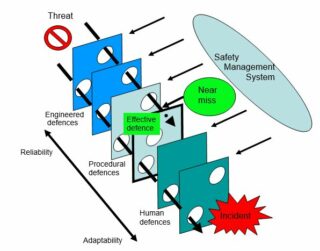Q Exchange
Really Reducing Harm – Thinking differently about managing risks in healthcare
- Idea
- 2018

Meet the team: Hu-Tech & NUH
Also:
- Dr Rob Morris
- Elaine Belshaw
- Prof Bryn Baxendale
- Giulia Miles
Aims:
Working with teams who are managing complex risks – in particular the teams managing Inpatient Falls risks and incidents – to use barrier-based methods to understand a wider view of risks and the performance of defences (barriers) to prevent or mitigate them.
Indicate to the Trust and Q community, the likely resources required (learning time, training content & materials, software costs, project/staff time, expert input and roll-out mechanisms) to enable a successful introduction of these Risk Management and Human Factors skills.
Who benefits?:
The Trusts – who gain understanding, methods and skills to further manage risks in a proactive manner using a barrier-based approach and Bow-Tie models.
The patients, families and staff colleagues – who are able to reduce the number and severity of incidents (including falls) by supporting and resourcing those defences that are most effective and have the largest impact.
Hu-Tech – who will gain a better understanding of the needs of Trusts and their difficulties in managing risks at a range of levels, gaining exposure to Healthcare settings that will improve their skills in developing the most relevant solutions.
Work to date:
The NUH trust-wide Inpatient Falls Committee (IPFC) have made massive 50% reduction over 5 years in the rate of inpatient falls. Management now focusses on better supervision of patients most immediately at risk, through cohort nursing, prevention and management of delirium and proactive toileting regimes.
Over 360 investigations of fall incidents, resulting in at least moderate harm, provide a large body of data, over the last 5 years, to inform and develop the understanding of risks, both local and more diverse, that contribute to the incidents.
Hu-Tech have been developing the application in healthcare settings of the barrier-based Risk Management approach and the Bow-Tie modelling, routinely used in a range of high hazard industries such as Oil & Gas, Rail, and Aviation. Projects using the Bow-Tie Diagrams to highlight needs for barrier improvements and focusing of resources include:
- · Derby Teaching Hospital NHS Foundation Trust (RDH) on ‘Identification and Management of Acute Hypercapnic Respiratory Failure’
- · West Midlands Academic Health Science Network’s (WHAHSN) Patient Safety Collaborative on ‘Detection and Management of Fetal Deterioration’
- · Representation of Local Safety Standards for Invasive Procedures (LocSSIPs) to demonstrate undefended routes to incidents during prosthesis verification.
Methods and Measures:
1. Hu-Tech will run initial training courses in the barrier-based Risk Management approach and Bow-Tie methodology as applied to healthcare in general and to the Falls Team’s priorities in particular.
2. Feedback on the content and learning will be collected.
3. Ability to apply new skills to the workplace and work schedule will be reviewed via team feedback and follow-up focus groups.
4. Additional skills development training may be developed with a focus on the issues and difficulties identified by teams. This may be retaining of knowledge of new techniques or understanding of the method requirements, or time allowed during normal duties to apply the methods. Any other issues will be addressed also.
5. Contribution to projects will be provided by Hu-Tech to ensure the accuracy of the Bow-Tie models developed and the use of the data applied to them.
6. Investigations of incidents supported by the Bow-Tie models will be undertaken (preferably on previous incidents where all the information is available) and the development of recommendations will be based on the new understanding of the types of risks contributing to the incident, including latent failures, system break-downs, barrier performance degradation etc.
7. Final review information collected from staff groups (via workshop or 1-to-1 interview) based on their ability to make use of this approach within their department or Trust. Information on resourcing, funding, timing, planning and application of tools will be discussed.
8. Production of a summary report detailing successes or difficulties in applying this approach to risk management in specific areas. Detail of resources required in each case and any variations between Trusts, with a view given on the reasons for variations. Indications of next steps or further study will also be given.
Q involvement:
Any Q colleagues or their Trusts are invited to be involved, up to a number that can reasonably be trained and supported on their projects (to be determined by interest). They will be able to take back to their project and Trust the skills, methods and information on a barrier-based Risk Management approach that would not normally be available without incurring external costs to each trust individually.
Development and Spread:
Each Trust involved in the project will be able to make informed choices about the cost effectiveness of this approach that is developing support within Healthcare.
They should come away with a realistic understanding of the investment of time and resources required by this proactive approach to make a beneficial impact on the level of risk, management of risks and the ability to direct resources specifically to areas that will control risks.
How you can contribute
- Volunteers to attend some training in Barrier-Based Risk Management techniques
- Projects that are investigating ways of reducing risks of harm due to recurring, known incidents
- Access to teams who have a range of investigations of similar incidents leading to at least moderate harm
Further information
Hu-Tech&NUH QExchange Bid May2018 (PDF, 161KB)